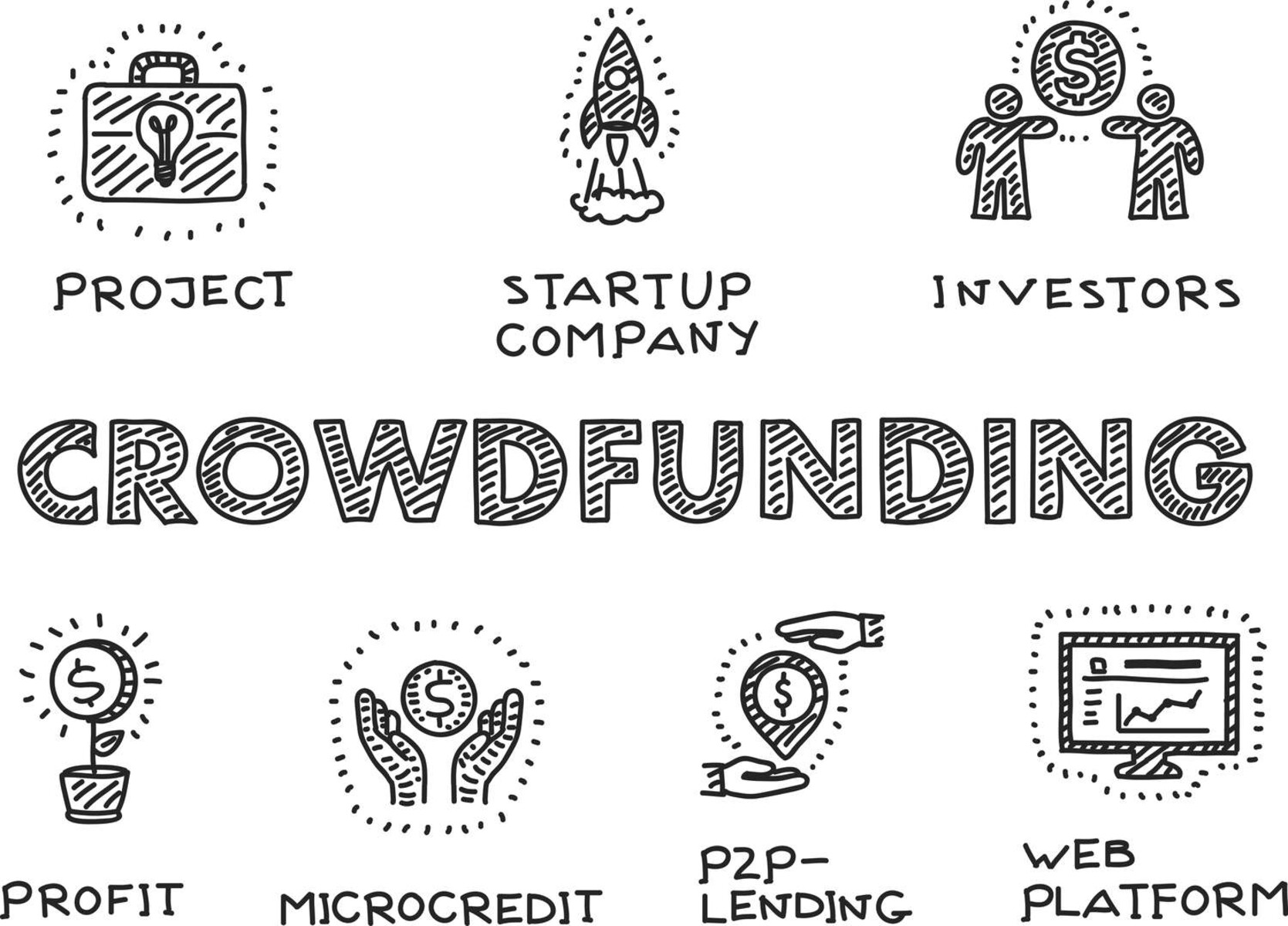Introduction
When it comes to financing options, crowdfunding and peer-to-peer (P2P) lending have emerged as popular alternatives to traditional bank loans. Both these methods provide individuals and businesses with opportunities to raise funds, but they operate in distinct ways. Understanding the key differences between crowdfunding and P2P lending is essential for anyone considering these options.
Crowdfunding and P2P lending have gained traction in recent years, thanks to the rise of online platforms that connect borrowers with potential investors. These platforms have revolutionized the way people access capital, enabling them to tap into a network of individuals willing to invest in their ventures.
Crowdfunding is a method of raising funds whereby individuals or businesses use online platforms or social media to gather small contributions from a large number of people. These contributors, or “backers,” are usually motivated by the project’s concept or by the possibility of receiving a reward in return for their investment. In contrast, P2P lending is a method of borrowing funds directly from individual investors through online platforms, cutting out the traditional financial intermediaries.
In this article, we will explore the differences between crowdfunding and P2P lending, considering factors such as the fundraising purpose, investor profiles, investment structure, risk and return, regulation, loan repayment, transparency and control, accessibility and eligibility, and the types of projects each method supports. Whether you’re a borrower or an investor, understanding these differences will help you make an informed decision about which option aligns best with your financial goals.
Overview of Crowdfunding
Crowdfunding is a method of raising funds by leveraging the power of a large group of people, typically through online platforms or social media. It allows individuals or businesses to pitch their ideas or projects to a wide audience and seek financial contributions from people who are interested in supporting them.
There are several different types of crowdfunding, including reward-based crowdfunding, donation-based crowdfunding, equity crowdfunding, and debt-based crowdfunding.
In reward-based crowdfunding, backers contribute funds to a project in exchange for a reward or a product. For example, if someone is crowdfunding the production of a new gadget, they might offer early access to the gadget or exclusive merchandise as rewards for different contribution levels.
Donation-based crowdfunding focuses on raising funds for charitable causes or community projects. Contributors donate money without the expectation of any financial return. This type of crowdfunding is often utilized for disaster relief efforts, medical expenses, or funding artistic endeavors.
Equity crowdfunding allows individuals to invest in a company or business in exchange for equity or ownership in that entity. This type of crowdfunding is typically utilized by startups or early-stage companies seeking capital to grow their business. Investors have the potential to receive financial returns if the company succeeds.
Debt-based crowdfunding, also known as peer-to-peer lending, enables individuals or businesses to borrow money from a group of investors. Borrowers repay the loan over a specified period, usually with interest. This type of crowdfunding offers an alternative to traditional bank loans, providing borrowers with access to funds and allowing investors to earn returns on their investment through interest payments.
One of the key advantages of crowdfunding is that it allows individuals or businesses to access funds from a large number of people, increasing the chances of successfully raising the required capital. Additionally, crowdfunding can help raise awareness about a project, product, or cause, allowing for broader exposure and potential publicity.
However, it is important to note that crowdfunding does come with certain risks. Not all projects or campaigns will be successful in reaching their funding goals, and there is no guarantee that investors will receive a return on their investment. It is important for both backers and project owners to carefully evaluate the risks and rewards before participating in crowdfunding campaigns.
Overview of P2P Lending
Peer-to-peer (P2P) lending, also known as marketplace lending, is a method of borrowing funds directly from individual investors through online platforms, eliminating the need for traditional financial institutions like banks. P2P lending has gained popularity as a viable alternative to traditional lending options, providing borrowers with access to funds and allowing investors to earn returns on their investments.
In a P2P lending model, borrowers create loan listings on online platforms, outlining the loan amount, purpose, and interest rate. These listings are then made available to potential investors who can choose to fund all or a portion of the loan based on their risk appetite and investment preferences.
Unlike traditional loans, P2P lending offers borrowers more flexibility and often faster access to funds. The loan application process is typically streamlined, and approval decisions can be made within a shorter timeframe compared to traditional bank loans. Additionally, P2P lending platforms often consider alternative credit metrics beyond credit scores, giving borrowers with less-than-perfect credit histories the opportunity to secure loans.
For investors, P2P lending provides an opportunity to diversify their investment portfolios and potentially earn higher returns than traditional investment options. By lending money directly to borrowers, investors can earn interest on the principal amount they lend. P2P lending platforms often provide tools and data to help investors assess the risk associated with different loan listings, allowing them to make informed investment decisions.
However, it is important to note that P2P lending does carry certain risks. As with any investment, there is a risk of default, where borrowers are unable to repay their loans. Investors should carefully evaluate the creditworthiness of borrowers and diversify their investment across multiple loans to mitigate the risk. Additionally, P2P lending platforms may have varying levels of regulation and oversight, so investors should conduct thorough research and choose reputable platforms.
Overall, P2P lending offers an alternative to traditional banking for both borrowers and investors. It provides borrowers with access to funds and flexibility in loan terms, while investors can potentially earn attractive returns. However, it is essential for both parties to understand the risks and rewards associated with P2P lending before participating in this form of borrowing and investing.
Key Differences between Crowdfunding and P2P Lending
While both crowdfunding and peer-to-peer (P2P) lending provide alternative fundraising options, there are several key differences between the two methods:
- Fundraising Purpose: Crowdfunding is typically used to raise funds for creative projects, entrepreneurial ventures, or charitable causes. P2P lending, on the other hand, focuses on borrowing funds for personal or business needs, ranging from debt consolidation to financing a new business venture.
- Investor Profiles: In crowdfunding, individuals or businesses seek contributions from a large number of people who are interested in supporting their projects. These individuals, known as backers, may be motivated by the project’s concept or potential rewards. In P2P lending, the investors are typically individuals or institutional investors looking to lend money and earn a return on their investment.
- Investment Structure: In crowdfunding, individuals contribute funds to a project in exchange for a reward or a product, or they donate money without expecting any financial return. In P2P lending, investors lend money to borrowers and earn interest on the principal amount they lend, similar to traditional lending.
- Risk and Return: Crowdfunding is associated with higher risks as backers may not receive any financial return if the project fails. P2P lending carries the risk of borrower default, where borrowers are unable to repay the loan, but investors have the potential to earn interest on their investment if the borrowers repay the loan as agreed.
- Regulation and Legal Considerations: Crowdfunding platforms are subject to various regulations and legal requirements, depending on the country or jurisdiction. P2P lending platforms also face regulations, but they may be subject to additional lending regulations and licensing requirements.
- Loan Repayment: In crowdfunding, backers typically do not expect repayment of their contributions unless it is a reward-based campaign. In P2P lending, borrowers have an obligation to repay the loan amount plus interest to the investors according to the agreed-upon terms.
- Transparency and Control: Crowdfunding campaigns often involve limited control for backers over the project’s execution and may rely on the trustworthiness of the project creator. In P2P lending, investors have more control over their investments, choosing specific loans to fund based on their risk appetite and investment preferences.
- Accessibility and Eligibility: Crowdfunding platforms are generally accessible to anyone with a project or cause, and the eligibility criteria may vary depending on the platform and campaign type. P2P lending platforms may have certain eligibility requirements for borrowers, such as credit history, income, and loan purpose.
- Project Types: Crowdfunding is suitable for a wide range of projects, including creative endeavors, social causes, and business startups. P2P lending is more focused on personal or business loans, allowing borrowers to address specific financial needs.
Understanding these key differences can help individuals and businesses determine which method aligns best with their unique fundraising or investment goals. Whether it’s funding a creative project or accessing capital for personal or business needs, both crowdfunding and P2P lending offer viable alternatives to traditional financing options.
Fundraising Purpose
Crowdfunding and peer-to-peer (P2P) lending differ in terms of their fundraising purposes. Understanding the specific goals and objectives of each method is crucial when deciding which option to pursue.
Crowdfunding primarily aims to raise funds for projects, whether they are creative endeavors, entrepreneurial ventures, or charitable causes. Individuals or businesses seeking funding for their projects create campaigns or listings on crowdfunding platforms and invite potential backers to contribute financially. The fundraising purpose for crowdfunding can be diverse, ranging from funding a new product development to supporting a community project or launching a creative idea.
On the other hand, P2P lending focuses on borrowing funds for personal or business purposes. Borrowers in P2P lending may utilize funds to consolidate debt, finance a home renovation, start a new business, or cover unexpected expenses. The fundraising purpose in P2P lending is more closely tied to fulfilling specific financial needs and objectives.
The distinct fundraising purposes in crowdfunding and P2P lending can impact the type of projects or ventures that each method caters to. Crowdfunding is often associated with innovative startups, artistic projects, social causes, and community initiatives. It provides an opportunity for individuals or businesses to present their ideas to a broader audience, tapping into a network of potential supporters who resonate with their vision.
P2P lending, on the other hand, addresses more immediate financial needs. It offers a platform for individuals or businesses to acquire necessary funds in a streamlined manner. Whether it’s consolidating debt or financing a personal or business project, P2P lending provides a direct avenue to access capital without going through traditional banking channels.
Ultimately, the specific fundraising purpose and objectives play a crucial role in determining whether crowdfunding or P2P lending is the right method to pursue. Individuals or businesses should evaluate their funding requirements and consider which method aligns best with their specific project or financial needs.
Investor Profiles
Crowdfunding and peer-to-peer (P2P) lending attract different types of investors, each with their own motivations and investment preferences. Understanding the profiles of investors in each method is essential when determining which option aligns best with your fundraising or investment goals.
In crowdfunding, investors are often referred to as backers or contributors. These individuals are typically motivated by the concept or idea behind the project and are driven by a desire to support the project’s success. Crowdfunding can attract a diverse range of backers, including individuals who are passionate about a specific cause, early adopters looking for unique products or experiences, or supporters of creative endeavors. Backers in crowdfunding campaigns often contribute funds in exchange for rewards or perks offered by the project creators.
On the other hand, P2P lending platforms cater to a different set of investors. These investors are primarily focused on lending money to borrowers and earning interest on their investments. P2P lending investors can range from individuals seeking alternative investment opportunities to institutional investors looking to diversify their portfolios. They may have specific investment criteria and risk tolerance levels that guide their investment decisions in P2P lending.
The investor profile in P2P lending is typically more financially driven, with investors seeking to generate returns on their investments over the loan term. The decision to invest in P2P lending is often guided by factors such as the interest rates offered, the creditworthiness of the borrowers, and the potential risk and return associated with different loan listings. P2P lending platforms provide tools and data to help investors evaluate the risk profiles of borrowers and make informed investment decisions.
It is important to note that both crowdfunding and P2P lending attract a mix of retail investors and institutional investors, but the focus and motivation may vary. While crowdfunding backers are driven by the project’s concept or an emotional connection to the cause, P2P lending investors are often primarily focused on financial returns.
Understanding the investor profiles in crowdfunding and P2P lending can help individuals or businesses tailor their fundraising efforts or investment strategies accordingly. It is crucial to consider the motivations and expectations of the investors in each method and ensure that your approach aligns with their preferences.
Investment Structure
Crowdfunding and peer-to-peer (P2P) lending differ in their investment structures, outlining how funds are contributed or lent to borrowers. Understanding the investment structure of each method is crucial when deciding which option is suitable for your fundraising or investment needs.
In crowdfunding, the investment structure is primarily based on contributions made by individuals or backers who support a specific project. Backers contribute funds to the project in exchange for various rewards or perks offered by the project creators. These rewards can range from early access to the product being developed to exclusive merchandise, personalized experiences, or other non-financial benefits. The investment structure in crowdfunding is focused more on supporting the project or cause than directly seeking financial returns from the investment.
On the other hand, P2P lending operates on a more traditional lending model, where investors lend money directly to borrowers through online platforms. The investment structure in P2P lending revolves around investors providing loans to borrowers and earning interest on the principal amount they lend. The interest rates are determined based on factors such as the borrowers’ creditworthiness, loan term, and prevailing market conditions. Investors receive periodic interest payments as borrowers repay the loan over the agreed-upon term.
The investment structure in P2P lending allows individuals or businesses seeking funds to secure loans without going through traditional banking institutions, providing more flexibility and potentially quicker access to capital. For investors in P2P lending, the investment structure offers the opportunity to diversify their investment portfolios, earn interest income, and potentially generate higher returns compared to traditional investment options.
It is important to consider the level of risk associated with each investment structure. In crowdfunding, there is a risk that the project may not successfully fulfill its objectives or may fail to deliver on the promised rewards. Backers in crowdfunding are typically aware of these risks and contribute funds with the understanding that they may not receive direct financial returns. In P2P lending, the primary risk is borrower default, where borrowers are unable to repay their loans. Investors should carefully assess the creditworthiness and risk profiles of borrowers before lending funds.
Understanding the investment structure of crowdfunding and P2P lending is crucial for both project owners or borrowers and investors. It allows for a clear understanding of how funds are contributed or lent, the expected benefits, and the potential risks involved. Evaluating the investment structure is essential for making informed decisions and aligning with your financial goals and risk appetite.
Risk and Return
The risk and return associated with crowdfunding and peer-to-peer (P2P) lending differ, reflecting the nature of these investment methods. Understanding the risk and potential returns in each method is crucial when considering which option aligns best with your investment preferences and financial goals.
Crowdfunding carries certain risks, particularly for backers. There is a risk that the project may not reach its funding goal, resulting in the project being canceled or delayed. Additionally, even if a project is successful, there is no guarantee that backers will receive any financial return on their investment. Crowdfunding backers are driven by their belief in the project’s concept or the desire to support a cause rather than seeking direct financial returns.
On the other hand, P2P lending carries its own set of risks. The primary risk in P2P lending is borrower default, where borrowers are unable to repay their loans. Investors should carefully evaluate the creditworthiness of borrowers and diversify their investments across multiple loans to mitigate this risk. P2P lending platforms often provide tools and data to help investors assess the risk associated with different loan listings.
In terms of potential return, the returns in crowdfunding are primarily non-financial rewards or perks offered by project creators to backers. These rewards can range from early access to the product being developed to exclusive experiences. While there may be cases where backers receive financial returns, such as equity crowdfunding where backers receive a stake in the project, the focus is mainly on supporting the project rather than generating financial returns.
In P2P lending, investors have the potential to earn financial returns in the form of interest payments. The interest rates are determined based on factors such as borrowers’ creditworthiness, loan term, and prevailing market conditions. Investors receive periodic interest payments as borrowers repay the loan over the agreed-upon term. P2P lending has the potential to provide investors with a regular income stream and potentially higher returns compared to traditional investment options.
It’s important to note that both crowdfunding and P2P lending carry certain risks, and there are no guarantees of financial returns. Project or loan defaults can occur, which may result in potential losses for backers or investors. It is crucial for individuals considering these methods to carefully evaluate the risks involved and compare them to their risk tolerance and investment goals.
Ultimately, the risk and return in crowdfunding and P2P lending differ in terms of the nature of the investment and the potential rewards. Individuals should carefully assess their risk appetite and financial objectives before deciding which method is best suited to their needs.
Regulation and Legal Considerations
Crowdfunding and peer-to-peer (P2P) lending are subject to different regulations and legal considerations, which can impact how these methods are operated and the level of protection offered to participants. Understanding the regulatory framework and legal considerations is crucial when engaging in either crowdfunding or P2P lending.
Crowdfunding platforms are subject to various regulations and legal requirements that vary depending on the country or jurisdiction. These regulations aim to protect both project creators and backers. They may include rules on disclosure of project details, financial reporting, investor protection, and anti-fraud measures. Crowdfunding platforms often have guidelines and processes in place to ensure compliance with these regulations and to maintain trust and transparency among participants.
Investors participating in crowdfunding campaigns should be aware of the potential risks, as there is no guarantee that the project will succeed or that contributors will receive the promised rewards. It is important for backers to conduct due diligence, assess the credibility of project creators, and evaluate the viability of the project before making financial contributions.
P2P lending platforms also face regulatory oversight, with varying levels of regulation depending on the country or region. These regulations typically pertain to lending practices, investor protections, and licensing requirements. P2P lending platforms may need to comply with financial regulations, such as Know Your Customer (KYC) and Anti-Money Laundering (AML) requirements, to ensure the integrity and security of the lending process.
For investors participating in P2P lending, it is important to carefully assess the credibility and compliance of the lending platforms. Investors should review the platform’s track record, its adherence to regulatory requirements, and its practices for evaluating and managing loan default risks. It is crucial to choose reputable platforms that prioritize transparency, borrower screening, and investor protections.
Moreover, borrowers in P2P lending should familiarize themselves with the legal implications of entering into a loan agreement. They should understand the terms and conditions, including interest rates, repayment schedules, fees, and any potential penalties for default. Borrowers should only engage with P2P lending platforms that are licensed and operate within the legal framework of their jurisdiction.
It is important to note that regulations and legal considerations surrounding crowdfunding and P2P lending may vary widely across different countries or regions. It is essential for all participants to stay informed about the specific regulations in their respective jurisdictions and to seek professional advice when necessary.
In summary, crowdfunding and P2P lending are subject to regulatory frameworks and legal considerations that aim to protect the interests of participants. Understanding these regulations and legal requirements is essential for both project creators and investors in order to operate within the boundaries of the law and to make informed decisions about participating in these methods.
Loan Repayment
Loan repayment in crowdfunding and peer-to-peer (P2P) lending differs in terms of the obligations and procedures involved. Understanding the loan repayment process is crucial for both borrowers and investors to ensure clarity and manage their financial commitments.
In crowdfunding, the concept of loan repayment depends on the specific campaign and the type of crowdfunding used. In reward-based crowdfunding, backers do not typically expect monetary repayment. Instead, they receive non-financial rewards or perks based on their contribution level. These rewards can range from early access to the product being developed to exclusive merchandise, personalized experiences, or other benefits related to the project or campaign.
In donation-based crowdfunding, contributors do not expect any financial return on their contributions. They make donations to support a cause or project without the expectation of repayment. The satisfaction for donors comes from knowing that they have made a positive impact or helped someone in need.
However, it is essential for project creators in crowdfunding to fulfill their promises and meet any obligations outlined in their campaign. This includes delivering rewards or perks within the specified timeframe and ensuring transparency and communication with their backers throughout the process.
On the other hand, in P2P lending, loan repayment is a fundamental aspect of the investment structure. Borrowers who secure loans through P2P lending platforms are required to repay the loan amount plus interest over a specified period. The repayment schedule is typically agreed upon between the borrower and the platform, and monthly installments are made to repay the loan to the individual investors who contributed funds.
P2P lending platforms often provide tools and processes for loan repayment, facilitating the transfer of funds from the borrower’s account to the investors’ accounts. Borrowers should adhere to the agreed repayment schedule to avoid any penalties or negative impact on their credit score. Investors receive regular interest payments on their investments until the loan is fully repaid.
It is crucial for borrowers in P2P lending to carefully assess their ability to make loan repayments before entering into a loan agreement. They should consider their financial capacity, cash flow, and other obligations to ensure that they can fulfill their loan repayment obligations.
For investors participating in P2P lending, loan repayment is an important consideration for their investment returns. They should evaluate the potential risks associated with borrower default and diversify their investments across multiple loans to mitigate any potential losses.
Overall, loan repayment in crowdfunding and P2P lending differs significantly. While crowdfunding primarily offers non-financial rewards or perks to backers, P2P lending focuses on loan repayment with interest for investors. Understanding the loan repayment process is vital for both borrowers and investors to manage their financial responsibilities effectively and ensure a positive experience in their respective funding or investment journeys.
Transparency and Control
Transparency and control are important factors to consider when comparing crowdfunding and peer-to-peer (P2P) lending. These aspects impact the level of visibility and influence that participants have over the investment process and the project’s progress.
In crowdfunding, transparency is valued, and project creators are expected to provide detailed information about their projects. Crowdfunding platforms often require project creators to disclose the purpose, timeline, and objectives of their projects, as well as the expected use of funds. This transparency allows potential backers to make informed decisions about whether to support the project. Throughout the campaign, project creators are encouraged to provide regular updates to backers, ensuring transparency and maintaining their trust.
However, backers in crowdfunding campaigns play a limited role in controlling the project’s execution or decision-making. Their contributions are primarily in the form of financial support, and the project creators retain the responsibility for project management and decision-making. Backers rely on the trustworthiness and competence of the project creators to deliver on their promises and meet the project’s objectives.
On the other hand, P2P lending offers investors a higher level of transparency and control. P2P lending platforms provide investors with detailed information about loan listings, including the borrower’s creditworthiness, loan purpose, interest rate, and repayment terms. This transparency allows investors to assess the risk and potential returns associated with each loan opportunity.
Investors in P2P lending have more control over their investments compared to crowdfunding backers. They can choose to fund specific loan listings based on their risk appetite and investment preferences. They have the freedom to evaluate different loan opportunities and select those that align with their investment goals and criteria. P2P lending platforms often provide tools and data to assist investors in evaluating loan listings and managing their investment portfolios.
Moreover, in P2P lending, both borrowers and investors benefit from transparency in terms of the loan agreement and repayment process. The terms and conditions of the loan, including interest rates, repayment schedules, fees, and potential penalties for default, are clearly outlined. This transparency ensures that all parties are aware of their rights and obligations throughout the loan term.
It is important for participants in both crowdfunding and P2P lending to carefully review the platforms they are using and understand the level of transparency and control they offer. Evaluating the platform’s reputation, transparency measures, and track record can help ensure a positive experience and provide participants with the necessary information to make informed decisions.
In summary, transparency and control vary in crowdfunding and P2P lending. While crowdfunding emphasizes transparency in project details and updates, ultimate control lies with the project creators. In P2P lending, investors have greater transparency in evaluating loan opportunities and more control in selecting and managing their investments. Participant awareness of the level of transparency and control is vital in choosing the method that best aligns with their preferences and investment goals.
Accessibility and Eligibility
Crowdfunding and peer-to-peer (P2P) lending differ in terms of accessibility and eligibility criteria. Understanding these factors is important when considering which method is the most suitable for your fundraising or investment needs.
Crowdfunding platforms are generally accessible to anyone with a project or cause, making it a popular choice for individuals or businesses seeking funding. The accessibility of crowdfunding allows for a wide range of projects to be launched and supported. Whether it’s a creative project, a social cause, or a business startup, crowdfunding provides an opportunity for individuals to showcase their ideas and connect with potential backers.
However, while crowdfunding platforms may be accessible to many, not all projects receive the same level of attention or funding. The success of a crowdfunding campaign depends on various factors, including the quality of the project, marketing efforts, and the ability to engage and attract backers. Project creators must actively promote their campaign and engage with the crowdfunding community to increase their chances of reaching their funding goal.
P2P lending platforms also offer accessibility for borrowers, providing an alternative to traditional bank loans. P2P lending platforms often have less stringent eligibility criteria compared to traditional banking institutions. Borrowers may have more flexibility in securing loans, especially if their credit history does not meet the criteria established by traditional lenders.
However, borrowers in P2P lending still need to meet certain eligibility requirements such as creditworthiness, income verification, and loan purpose. The specific criteria may vary depending on the platform and the loan request. While P2P lending offers accessibility, it is essential for borrowers to carefully assess their financial capacity to repay the loan and determine if P2P lending aligns with their borrowing needs.
For investors, accessibility to both crowdfunding and P2P lending platforms can vary based on the local regulations and the platform’s requirements. Some platforms may have restrictions or limitations on who can participate as an investor, such as geographical limitations or income thresholds. Investors should review the eligibility criteria set by the platform to determine if they meet the requirements for participation.
It is important to note that while crowdfunding and P2P lending offer accessibility to a wider range of individuals and businesses, each method has its own set of criteria and requirements. Potential participants should carefully review the eligibility criteria and assess whether they fulfill the necessary requirements before engaging in either method.
Accessibility and eligibility play a critical role in determining the suitability of crowdfunding or P2P lending for your specific goals. Having a clear understanding of these factors will help individuals or businesses determine which method aligns best with their needs and increase their chances of successful fundraising or successful investments.
Project Types
Crowdfunding and peer-to-peer (P2P) lending support different types of projects, making each method suitable for different funding purposes and ventures. Understanding the types of projects that thrive in each method is crucial for individuals or businesses seeking funding.
Crowdfunding is known for its versatility, supporting a wide range of project types. It has gained popularity as a platform for creative projects, such as music albums, films, art exhibitions, and book publications. Many artists and entrepreneurs use crowdfunding to bring their ideas to life and engage with their audience directly. Additionally, crowdfunding has also become a go-to option for social causes, community initiatives, and nonprofit organizations seeking financial support.
Entrepreneurs and startups often turn to crowdfunding to fund the development of innovative products or technologies. This allows them to showcase their ideas and attract potential backers who are interested in being part of groundbreaking ventures. Crowdfunding enables project creators to tap into a community of like-minded individuals who share their passion for the project’s concept or cause.
P2P lending, on the other hand, is primarily focused on providing loans for personal or business purposes. Borrowers in P2P lending can access funds for various needs, including debt consolidation, home renovations, educational expenses, and starting or expanding a business.
Unlike crowdfunding, P2P lending is less focused on creative projects or artistic ventures. It is more inclined towards financing tangible needs and goals. P2P lending offers an alternative to traditional bank loans, providing borrowers with faster access to capital and potentially more favorable terms.
Entrepreneurs and small business owners often utilize P2P lending to secure financing for their ventures. This enables them to avoid the lengthy and complex loan approval processes typically associated with traditional banking institutions. P2P lending allows borrowers to access funds based on their creditworthiness and the viability of their business plans.
It is important to note that while crowdfunding has a broad range of project types, P2P lending may have certain limitations based on the platforms and regulations in place. Some P2P lending platforms may have restrictions on specific industries or loan purposes. Borrowers should carefully review the platform’s guidelines and eligibility requirements to ensure their project aligns with the platform’s focus and criteria.
Understanding the types of projects that thrive in crowdfunding and P2P lending is essential for individuals or businesses seeking funding. It enables them to identify the method that best aligns with their project’s nature and purpose. Whether it’s a creative endeavor, a community initiative, or a business venture, both crowdfunding and P2P lending offer viable options for individuals and businesses looking to secure funding.
Conclusion
Crowdfunding and peer-to-peer (P2P) lending are both alternative financing methods that have gained popularity in recent years. While they share some similarities, they also have distinct characteristics that make each method unique. Understanding the differences between crowdfunding and P2P lending is crucial for individuals and businesses looking for fundraising or investment opportunities.
Crowdfunding offers a platform for individuals or businesses to raise funds for creative projects, social causes, and entrepreneurial ventures. It provides opportunities for individuals to connect with potential backers who are interested in supporting their projects. However, crowdfunding primarily relies on non-financial rewards or perks for backers, and there is no guarantee of financial returns. The success of a crowdfunding campaign depends on various factors, including effective project promotion and engaging the crowdfunding community.
P2P lending, on the other hand, focuses on borrowing funds directly from individual investors. It offers an alternative to traditional bank loans and provides borrowers with quicker access to capital. Investors in P2P lending have the opportunity to earn interest on their investments. However, there is a risk of borrower default that investors need to consider. P2P lending platforms offer transparency, allowing investors to evaluate loan listings and make informed investment decisions.
When deciding between crowdfunding and P2P lending, individuals or businesses should consider factors such as fundraising purpose, investor profiles, investment structure, risk and return, regulation, loan repayment, transparency, control, accessibility, eligibility, and project types. Assessing these factors will help determine which method aligns best with specific goals, risk tolerance levels, and financial needs.
Both crowdfunding and P2P lending provide viable alternatives to traditional financing options. They offer opportunities for individuals and businesses to access funds for various purposes and allow investors to diversify their investment portfolios. However, it is important to carefully evaluate the risks and rewards associated with each method.
Whether it’s financing a creative project, supporting a social cause, securing a personal or business loan, or seeking investment opportunities, individuals and businesses should weigh the pros and cons of crowdfunding and P2P lending to make informed decisions. By understanding the nuances of each method and aligning them with specific funding or investment goals, individuals can navigate these alternative financing options effectively.

























